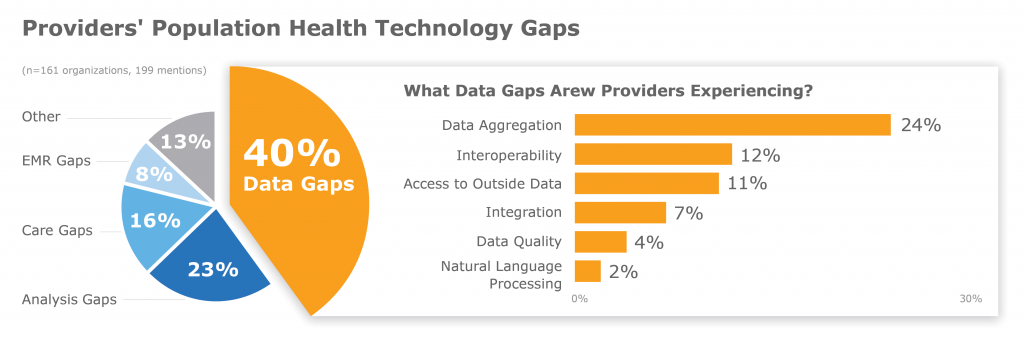 Healthcare is inarguably facing some of the most daunting challenges today, with the potential repeal of the Affordable Care Act (ACA), the uncertainty of the American Health Care Act (AHCA), numerous other regulations with which providers must comply, new payment models, and much more.
Healthcare is inarguably facing some of the most daunting challenges today, with the potential repeal of the Affordable Care Act (ACA), the uncertainty of the American Health Care Act (AHCA), numerous other regulations with which providers must comply, new payment models, and much more.
At our recent Dimensional Insight Users Conference (DIUC17), Julie Beard from KLAS Research spoke at a couple of our breakout sessions about some of the biggest healthcare challenges providers indicate they are facing today and where the industry is headed.
1. Value-based care
Value-based care programs are gaining in popularity, and as we wrote about in a previous blog post, a recent survey from the Health Care Transformation Task Force shows that 41% of its members were in value-based payment arrangements at the end of 2015. This is up from 30% at the end of 2014. Task force members are also aiming for a goal of 75% in value-based arrangements by 2020.
Succeeding in value-based care requires providers to better understand and minimize costs. It also requires care improvements, given that providers in value-based arrangements will be paid by the episode, rather than on a fee-for-service basis.
As Julie discussed in her sessions, providers entering new risk-based contracts find it difficult to understand the true costs of care. Because of this, providers are turning to healthcare analytics to help in areas such as finance, so they can understand the costs related to entire episodes and prevent readmissions to reduce unnecessary trips back to the hospital and the financial implications of that.
2. Population health
“Population health” is a big buzzword in healthcare right now, but what does it mean? And what are providers doing in terms of population health? Providers and vendors are talking about population health, but the definition of population health varies. This past year, KLAS published the white paper titled, Population Health IT Definition, which resulted from the collaboration of 16 healthcare IT vendor companies, 3 healthcare services firms, 31 provider organizations and 2 payer organizations at the 2016 KLAS Keystone Summit.
Data aggregation, the first vertical of the Provider Population Health IT Framework, is proving to be most difficult for healthcare organizations. Providers struggle to bring together disparate data sources in a meaningful way. Below is an excerpt from the Population Health Management Perception July 2016 report showing a 40% data gap with data aggregation being at the top.

Source: http://data.klasresearch.com/report/population-health-perception-2016/1126
3. Interoperability
A third related challenge for healthcare organizations is interoperability between EHR systems. Clinicians need effortless access to a comprehensive view of the patient’s information to provide high value care. Right now, systems struggle to talk to each other, and provide the right information at the right time. Vendors and providers both point to standards as the main barrier to success.
Future of healthcare technology
Julie also discussed where healthcare technology and analytics may be headed. Here are a few areas in which she is seeing progress:
- Predictive analytics: Provider organizations are starting to indicate their use of predictive capabilities to make progress in areas such as risk of mortality, readmissions, and sepsis. This is important to providers efforts on cost control and patient outcomes as part of value-based care.
- Natural language processing/machine learning: Providers are looking for solutions leveraging technology to simplify the preparation, analysis and digestion of complex data for a self-service environment. Examples include simplification of the user interface with natural language query and incorporating machine learning in producing helpful content that they haven’t yet asked for. Providers are seeing some of this right now with specific healthcare applications.
- Employee experience: Providers are talking about the “Quadruple Aim” instead of just the Triple Aim, adding the importance of addressing healthcare workforce burnout impact on the patient experience. The advent of new technologies such as telehealth, may provide more flexible work arrangements for providers in the future.
- Transformative BI: Healthcare is in transition to a value-based care environment with a focus on wellness and prevention efforts to increase awareness through patient engagement and employer/insurance incentives. Healthcare BI technology will need to be adept at providing simpler, innovative, and transformative real-time data solutions that impact patient outcomes.
The Dimensional Insight perspective
Here at Dimensional Insight, we continually talk about these challenges and how we can help our customers meet them head-on. To learn more about how we’re tackling these issues, check out some of our resources:
- Navigating the World of Value-Based Care with Analytics
- 3 Cornerstones for Healthcare Analytics Success
- How Henry Mayo Newhall Memorial Hospital Architected a Roadmap for BI Success
Ready for a test drive of our healthcare analytics software?
- Solving Hospital CEOs’ Pressing Challenges With Analytics - April 15, 2024
- Navigating the Wellness Wave: Wine & Spirits Data Strategy - April 9, 2024
- Takeaways from HIMSS24 - March 26, 2024


